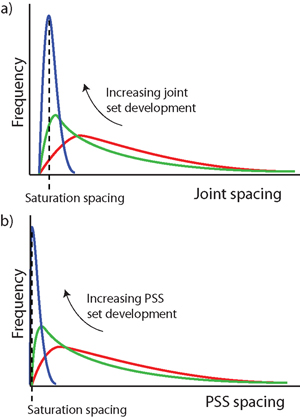| |||||||
|
|
|||||||
|
|
|||||||
| Pressure Solution Seam Spacing - Layer Thickness Scaling | |||||||
|
The dependence of joint array spacing on the thickness of beds in which the joints reside is well studied. Considering the anticrack analogy for PSSs, the spacing of PSS arrays may also depend on the bed thickness. To this end, there is not a lot of data. However, one data set available suggests a somewhat linear bed thickness-PSS spacing relationship. Figure 1 shows a plot based on the measurements along scanlines across a pavement of a sandstone outcrop. Although the number of measurements is not large enough to be confident about any generalization of the form of the trend and there is a large spread in the central part of the graph, an increasing spacing with increasing bed thickness for a given strain magnitude may be inferred. However, care is required to extend the spacing-bed thickness trend for joints to PSSs as elaborated below.
There appears to be some important differences between the evolution of joint spacing and PSS spacing (Nenna et al., 2012). The most important one is that joints have a well-defined spacing saturation, while PSSs do not. The spacing of PSS arrays can be ever decreasing, at least conceptually, in response to large amounts of strain. Figure 2 shows two conceptual diagrams illustrating this difference. | |||||||
| Reference: |
|||||||
| Nenna, F., Zhou, X., Aydin, A., 2012 |
|||||||
|
Readme | About Us | Acknowledgement | How to Cite | Terms of Use | Ⓒ Rock Fracture Knowledgebase |
|||||||

